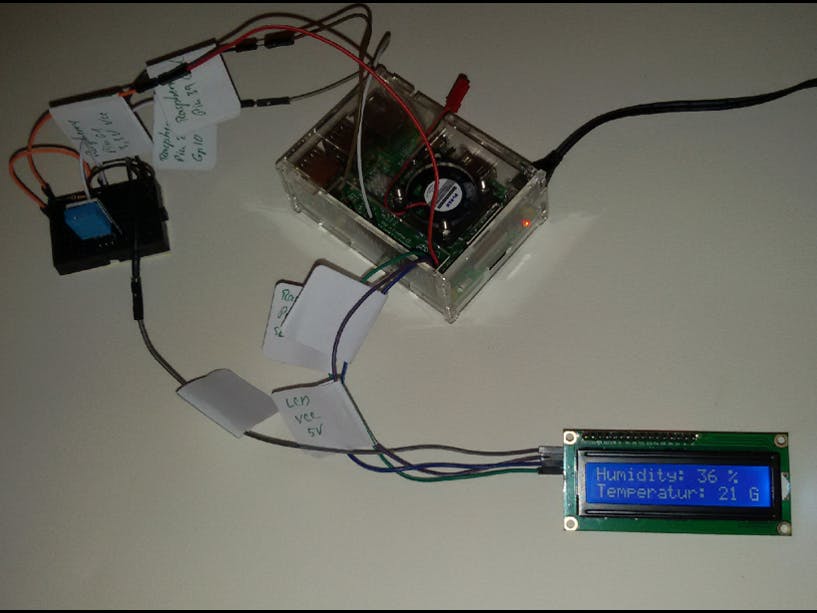Hardware components | ||||||
 |
| × | 1 | |||
 |
| × | 1 | |||
 |
| × | 1 | |||
Temperaturlogger - windows 10 IOT / Azure Messaging hub example project - MainPage.xaml
C#Project folder in compressed rar file.
The azure key values are removed and have to be replaced with your own access keys.
Azure related code sequences are therefore commented out.
Please get the complete project files on github: https://github.com/bieblsoft/Raspberry-IOT-Temperatureexample
The azure key values are removed and have to be replaced with your own access keys.
Azure related code sequences are therefore commented out.
Please get the complete project files on github: https://github.com/bieblsoft/Raspberry-IOT-Temperatureexample
using DisplayI2C;
using Microsoft.Azure.Devices.Client;
using Newtonsoft.Json;
using Sensors.Dht;
using System;
using System.Collections.Generic;
using System.Text;
using System.Threading.Tasks;
using Windows.Devices.Enumeration;
using Windows.Devices.Gpio;
using Windows.Devices.I2c;
using Windows.UI.Xaml;
using Windows.UI.Xaml.Controls;
namespace TemperaturLogger
{
public sealed partial class MainPage : Page
{
private DispatcherTimer timer;
private GpioController gpio;
private Sensors.Dht.Dht11 _dht;
private GpioPin _pin;
private Single Temperature;
private Single Humidity;
private DateTimeOffset Date;
private DhtReading reading;
private I2cDevice LCDDisplay;
private displayI2C Display;
static DeviceClient deviceClient;
//static string iotHubUri = "Endpoint=youtEndpoint/;" +
// "SharedAccessKeyName=RootManageSharedAccessKey;" +
// "SharedAccessKey=YourAccessKey" +
// "EntityPath=messagequeue";
//static string deviceKey = "YourDeviceKey"; // device key
//static string deviceId = "RaspiPC";
static string ConnectionString = "HostName=TemperaturHub.azure-devices.net;" +
"DeviceId=RaspiPC;" +
"SharedAccessKey=YourSharedKey";
public MainPage()
{
InitializeComponent();
GpioInit();
timer = new DispatcherTimer();
timer.Interval = TimeSpan.FromSeconds(5);
timer.Tick += Timer_Tick;
timer.Start();
}
~MainPage()
{
_dht.Dispose();
_pin.Dispose();
Display.clrscr();
LCDDisplay.Dispose();
}
private async void GpioInit()
{
gpio = GpioController.GetDefault();
if (gpio == null)
{
return;
}
_pin = gpio.OpenPin(5);
_dht = new Dht11(_pin, GpioPinDriveMode.Input);
LCDDisplay = await InitializeDisplay();
Display = new displayI2C(LCDDisplay);
Display.init();
}
private async void Timer_Tick(object sender, object e)
{
await ReadData();
ShowOnDisplay();
SendDeviceToCloudMessageAsync();
}
private async Task ReadData()
{
reading = new DhtReading();
try
{
reading = await _dht.GetReadingAsync();
}
catch( Exception e )
{
}
if (reading.IsValid)
{
this.Temperature = Convert.ToSingle(reading.Temperature);
this.Humidity = Convert.ToSingle(reading.Humidity);
this.Date = DateTimeOffset.Now;
F_Temperature.Text = Temperature.ToString();
this.F_Humidity.Text = Humidity.ToString();
this.F_Date.Text = Date.ToString(string.Format("dd.mm.yyyy, HH:MM:ss"));
}
else
{
throw new Exception("DHT Device did not answer");
}
}
private async Task<I2cDevice> InitializeDisplay()
{
// search for I2C Devices if needed
//List<byte> result = await FindDevicesAsync();
try
{
string i2cDeviceSelector = I2cDevice.GetDeviceSelector();
DeviceInformationCollection devices =
await DeviceInformation.FindAllAsync(i2cDeviceSelector);
DeviceInformation DI = devices[0];
var LCD_settings = new I2cConnectionSettings(0x27);
LCD_settings.BusSpeed = I2cBusSpeed.StandardMode;
LCD_settings.SharingMode = I2cSharingMode.Shared;
return await I2cDevice.FromIdAsync(DI.Id, LCD_settings);
}
catch( Exception e )
{
return null;
}
}
private void ShowOnDisplay()
{
Display.clrscr();
Task.Delay(3).Wait();
string Temp = "Humidity: " + Humidity.ToString() + " %";
Display.prints(Temp);
Temp = "Temperatur: " + Temperature.ToString() + " Grad";
Display.gotoSecondLine();
Display.prints(Temp);
}
private async void SendDeviceToCloudMessageAsync()
{
string str = String.Format(
"Temperatur um {0}: {1} C, Luftfeuchtigkeit: {2} %",
DateTime.Now.ToString(string.Format("dd.mm.yyyy, HH:MM:SS")),
Temperature.ToString(),
Humidity.ToString());
var telemetryDataPoint = new
{
deviceId = "RaspiPC",
Temperatur = Temperature,
Humidity = Humidity,
partition = 1
};
deviceClient = DeviceClient.CreateFromConnectionString(ConnectionString);
//Create(iotHubUri,
//new DeviceAuthenticationWithRegistrySymmetricKey(
// deviceId,
// deviceKey),
//Microsoft.Azure.Devices.Client.TransportType.Mqtt);
try
{
var messageString = JsonConvert.SerializeObject(telemetryDataPoint);
var message = new Microsoft.Azure.Devices.Client.Message(Encoding.UTF8.GetBytes(messageString));
await deviceClient.SendEventAsync(message);
}
catch( Exception e )
{
}
}
public async Task<List<byte>> FindDevicesAsync()
{
List<byte> returnValue = new List<byte>();
// Get a selector string that will return all I2C controllers on the system
string aqs = I2cDevice.GetDeviceSelector();
// Find the I2C bus controller device with our selector string
var dis = await DeviceInformation.FindAllAsync(aqs).AsTask();
if (dis.Count > 0)
{
const int minimumAddress = 8;
const int maximumAddress = 77;
for (byte address = minimumAddress; address <= maximumAddress; address++)
{
var settings = new I2cConnectionSettings(address);
settings.BusSpeed = I2cBusSpeed.FastMode;
settings.SharingMode = I2cSharingMode.Shared;
// Create an I2cDevice with our selected bus controller and I2C settings
using (I2cDevice device = await I2cDevice.FromIdAsync(dis[0].Id, settings))
{
if (device != null)
{
try
{
byte[] writeBuffer = new byte[1] { 0 };
device.Write(writeBuffer);
// If no exception is thrown, there is
// a device at this address.
returnValue.Add(address);
}
catch
{
// If the address is invalid, an exception will be thrown.
}
}
}
}
}
return returnValue;
}
}
}
0 projects • 2 followers
68 yrs. old C++ / C# Developer and Tutor, Freelancer, retired. Developer for over 45 Years



Comments